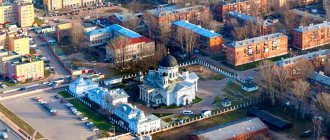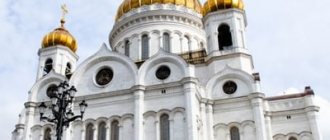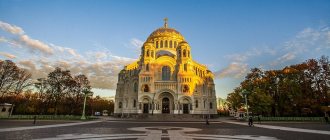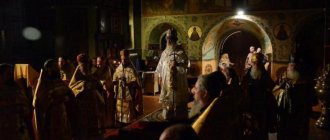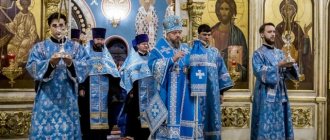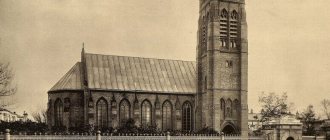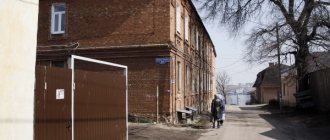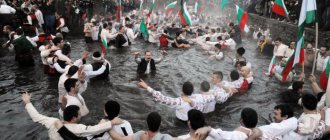Cathedral of Christ the Savior in Moscow
Cathedral of Christ the Savior
Moscow
Temple as a sign of gratitude. The main cathedral of the Russian Orthodox Church, the Cathedral of Christ the Savior, was built in honor of the victory of the Russian people over Napoleon's troops. Construction took almost half a century, and on June 7, 1883, according to the new style, the cathedral was consecrated. In December 1931, the temple-monument to military glory was destroyed by explosion, and in 2000 the cathedral was built again. Just like the main cathedral in Russia, many temples collapsed and were rebuilt from ruins. But they survived, although they lost most of their shrines.
Common features between a temple, a cathedral and a church
These three concepts designate buildings used for the creation of religious sacraments , rituals and prayers.
from each other in scale and interior decoration , although in modern times there are exceptions.
Also read how the Great Patriotic War differs from the First World War
Find out the difference between cable, analogue and digital television here
Guards Ribbon and St. George Ribbon - fundamental differences: https://gderaznica.ru/social/georgievskaya-i-gvardejskaya-lenta.html
Epiphany Cathedral in Elokhov in Moscow
Epiphany Cathedral in Elokhov in Moscow
Moscow
The temple in which Alexander Sergeevich Pushkin was baptized. Since 1938, the cathedral became a cathedral, and then the Patriarchal. From 1943 to 1991, the enthronement of the primates of the church - the patriarchs - took place here. They were either going to demolish the temple and expand Elokhinskaya Square, or they were going to make it a house of rare books or a cinema. But to this day, the cathedral remains a cathedral for the Moscow Patriarchate and preserves shrines: the icon “Cathedral of the Mother of God”, depicting 164 images of the Mother of God, the relics of St. Alexy of Moscow - one of the mentors of Dmitry Donskoy. The surroundings of Spartakovskaya Square in Moscow are echoed by the ringing of 17 bells that have been preserved since the 19th century.
Distinctive features of the church
House of the Lord in translation ; this word denotes the Orthodox world.
In terms of architecture, a church is a temple building of a small area with an altar . The interior decoration is quite modest . The service is performed by one clergyman . It is possible to perform one communion ceremony in 24 hours.
Assumption Cathedral in Smolensk
Assumption Cathedral in Smolensk
Smolensk
One of the most revered churches in Russia was built in memory of the heroic defense of the city from the troops of the Polish-Lithuanian Commonwealth. The temple on Cathedral Hill was founded by Vladimir Monomakh, but that church could not withstand the assault. The new cathedral took about a hundred years to build. Miraculously, the church survived the invasion of Napoleon, lost the helmet of the patron saint of Smolensk - Saint Mercury, but the Smolensk partisans recaptured the shroud donated by the Moscow Kremlin from the French. During the Great Patriotic War, the cathedral lost its main shrine - the Smolensk Icon of the Mother of God "Hodegetria", which came to Rus' in the 11th century. Now the cathedral houses an image of Hodegetria from the 17th century, copied from a miraculous icon under Tsar Ivan the Terrible.
Church of Lazarus and the Nativity of the Virgin Mary on Senya[edit]
The Church of Lazarus and the Nativity of the Virgin Mary on Senya is another ancient architectural monument of the Moscow Kremlin that has survived to our times. At the end of the 14th century. The widow of Dmitry Donskoy, Princess Evdokia, ordered the construction of a temple in memory of the Battle of Kulikovo. The church was built of white stone in 1393-94 on the site of the old wooden Church of the Resurrection of Lazarus and served as a house temple for the women who lived in the princely palace.
The painting of the church was carried out by Theophanes the Greek and Daniil Cherny with the participation of their students in 1395. From the construction of those times, the walls to the choir, the main portal and some windows have been preserved. In 1479, the top of the temple collapsed (presumably due to a fire), and the church was restored. Later, during the construction of the new princely palace, the architect Aleviz Novy also rebuilt the Church of the Nativity of the Virgin. According to the drawings of the early 17th century that have come down to us, it is clear that when rebuilding the temple, the architect used it as a basement, adding a new tier where the church altar was located. In the basement there was a chapel of Lazarus.
Today the church is inactive. Tourist access is closed to it.
Address:
Moscow, Kremlin, Palace street, Grand Kremlin Palace, White corridor
Cathedral of Equal-to-the-Apostles Prince Vladimir in Astrakhan
Cathedral of Equal-to-the-Apostles Prince Vladimir in…
Astrakhan region
The temple built in honor of the 900th anniversary of the Baptism of Rus'. A church was erected on the border of Russian and Tatar settlements for missionary purposes - to introduce Muslim Tatars to Orthodoxy. One of the chapels of the temple is St. Nicholas, who was revered even by Muslims, and most importantly by the sailors who lived in large numbers on the Astrakhan lands. According to legend, the cross was built from a cast iron anchor. The cathedral suffered many disasters. The temple has been a warehouse and a bus station. In 1919, warships shot at the church at point-blank range. According to legend, the fire stopped after the appearance of the face of the Virgin Mary on the dome of the cathedral. Among the especially revered shrines, especially by sailors, is the icon “St. Nicholas on the Waters,” donated by Admiral Vladimir Masorin.
Cathedral of the Icon of the Mother of God “The Sign” in the Znamensky Monastery in Kursk
Cathedral of the Icon of the Mother of God of the Sign in the Znamensky Monastery in…
Kursk region
Temple on the site of the city fortress. In 1612, the city was captured and devastated by Polish-Lithuanian troops. Only the citadel remained impregnable. In memory of the events, the monastery of the Kursk Icon of the Mother of God “The Sign” was built. Construction of the Znamensky Cathedral began in 1816. After the revolution, the “October” cinema was located in the majestic temple; the miraculous icon was taken out of the country by the Volunteer Army and ended up in the USA. Only in the 90s of the 20th century the temple became a cathedral, and among the shrines there appeared a copy of the image “The Sign”, written in 1902 by the monks of the Znamensky Monastery.
Kazan Cathedral
Kazan Cathedral
Saint Petersburg
A temple built on a historical site - instead of the court church of the Nativity of the Blessed Virgin Mary. Time and dampness damaged the wooden baroque, and Paul I decided to build a temple not inferior in grandeur to the Vatican's St. Peter's Cathedral. They demolished 11 houses on Nevsky and began to build according to the design of the former Stroganov serf Andrei Voronikhin. The cathedral became the legal successor of the demolished church. The tradition of honoring the Russian army after military victories has been preserved. Even the iconostasis of the cathedral is made from trophies - 40 pounds of trophy silver were spent on the cladding. The main shrine of the cathedral is a copy of the Kazan Icon of the Mother of God, Tsarina Praskovya Feodorovna, which came to St. Petersburg after the capital was moved in 1712.
Schedule of services
Divine services at the Compound of the Cathedral Church of St. Igor of Chernigov and Kyiv take place daily:
- 07.40 liturgy (Monday-Saturday);
- 17.40 evening worship (daily);
- 06.40 early liturgy (Sundays and holidays);
- 09.40 late liturgy (Sundays and holidays).
You can confess at the beginning of the liturgy or arrange for another time. During the day there is always a priest on duty in the church.
Schedule of services 2021
Panorama of the Church of St. Igor of Chernigov
Holy Assumption Cathedral in Makhachkala
Holy Assumption Cathedral in Makhachkala
The Republic of Dagestan
The main Orthodox church in the capital of Dagestan. Built in 1906 with donations from residents of the village of Port-Petrovsk, as Makhachkala was formerly called, and money from Nicholas II. It was consecrated in honor of the patroness of the Caucasus - the icon of the Iveron Mother of God. In the 90s of the twentieth century, the temple was practically empty, at that time Russian-speaking Makhachkala residents were leaving the city. But twenty years later, a new chapel was built in the temple in honor of Alexander Nevsky, and the vaults were painted anew. All the wall painting was carried out by local Muslim craftsmen under the guidance of the famous Dagestan artist Abdulzagir Musaev. The main shrine of the temple is copies of the gifts of the Magi from the Greek monastery of St. Paul.
Annunciation Cathedral of the Moscow Kremlin[edit]
The existing nine-domed cathedral was built at the end of the 15th - beginning of the 16th centuries, but at its base lies the basement of the temple from the reign of Dmitry Donskoy. The Blagoveshchensky basement is the oldest architectural monument in Moscow. To see it, you need to enter the door facing the porch of the Chamber of Facets. Behind the door is the archaeological exhibition of the Kremlin museums. However, it is currently closed for reconstruction.
Year of construction:
between approximately 1484 and approximately 1489.
Thrones:
Annunciation of the Blessed Virgin Mary, Gabriel the Archangel, Cathedral of the Blessed Virgin Mary, Entry of the Lord into Jerusalem, Alexander Nevsky, Nicholas the Wonderworker
Architectural style:
Early Moscow
Address:
Moscow, Kremlin, Sobornaya square.
St. Catherine's Cathedral
St. Catherine's Cathedral
Krasnodar
The main temple of the Ekaterinodar and Kuban diocese, one of the largest in Russia. Construction of the temple began after the crash of the royal train, on which Alexander III was returning from a trip to southern Russia. The entire royal family remained unharmed, and the local City Duma decided to build a temple in honor of this event. They built it conscientiously, and this saved the temple in the 30s. Egg white was used in the brickwork, and the cathedral was not blown up for fear of destroying the surrounding neighborhoods. The architect Ivan Malgerb also deserves credit for this. In 1944, the chapels of the cathedral were consecrated again, but no longer in honor of the heavenly patrons of members of the royal family. The main shrines of the temple are the relics of the Great Martyr Catherine and the Blessed Matrona of Moscow.
Novocherkassk Holy Ascension Cathedral
Novocherkassk Holy Ascension Cathedral
Novocherkassk
The main temple of the Don Cossack Army. Opened and consecrated in 1905. The cathedral is the seventh-highest dome in Russia. The cross is inlaid with 80 monoliths of rock crystal; because of its reflections, the temple is called “the second sun of the Don.” In the lower church lie the remains of the founder of the capital of the Don Cossacks, the “Whirlwind Ataman” Matvey Platov. In the 1930s, the gilded copper sheets were removed from the domes and the cathedral was turned into a storage facility for fuel oil. But 20 years later, thanks to historians, the temple began to be restored. Among the many shrines of the cathedral, the icon of the Assumption of the Mother of God, donated to the Don army at the end of the 19th century by Metropolitan Platon of Kyiv and Galicia, has survived.
Cathedral Church - what does it mean?
In the temple building, clergy conduct Orthodox rituals and perform prayers for believers. It is called cathedral when the highest church official with the third degree of clergy designates the building as the most important building in the city or temple complex.
It becomes cathedral forever . The service is conducted by the highest clergy from various Orthodox buildings.
All Saints Cathedral in Tula
All Saints Cathedral in Tula
Tula region
A snow-white 18th-century temple in the style of Russian classicism appeared in the ancient city after the plague epidemic. The cemeteries were moved outside the city walls, and in 1776, a cathedral was built at the All Saints Necropolis with merchant money. The icons for the one-story church were created by the icon painter and Tula gunsmith Grigory Belousov. In 1859, the architectural ensemble was complemented by an 82-meter bell tower with trumpeting angels - a gift from the church warden, merchant Pirozhnikov. But the first bells were stolen, and the guards were beaten with rods for negligence. The consecration of the bell tower took place four years later. Particularly revered in the church are the Athonite Icon of the Mother of God “Merciful”, the Kazan Icon and the Icon of St. Nicholas with a particle of his relics.
Spassky Cathedral of the Andronikov Monastery[edit]
The white-stone Spassky Cathedral of the Spaso-Andronikov Monastery, according to written sources, was erected under Abbot Alexander between 1410 and 1427.
The temple belongs to a small group of white stone structures built at the turn of the 14th-15th centuries. in the Moscow lands, where the princes recognized themselves as direct heirs to the traditions of Vladimir-Suzdal Rus', including in architecture. At the same time, the Spassky Cathedral differs in many ways from its contemporary churches, such as the Assumption Cathedral “on Gorodok” in Zvenigorod (around 1400), the Trinity Cathedral of the Trinity-Sergius Monastery (1422-1423), the Nativity Cathedral of the Savvino-Storozhevsky Monastery ( 1420-1430s.). Its features are associated with the influence of the traditions of Balkan architecture.
The Spassky Cathedral has undergone reconstruction throughout its history. In the 18th century, a covered porch was built around it. In 1812, during Napoleon's invasion, the cathedral was damaged by fire: the iconostasis was destroyed and the dome collapsed. In the middle of the 19th century. Side aisles were added to the building and topped with a hipped roof. Restorers P.N. Maksimov and B.A. Ognev managed to reveal what the ancient forms of the cathedral were. The cathedral was practically revived by restoration architects L.A. David, B.L. Altshuller, S.S. Podyapolsky, M.D. Tsiperovich. Thanks to the efforts of these people, the Spassky Cathedral took its rightful place in the history of Russian architecture. Currently, regular church services are held in the cathedral.
Address:
Russia, Moscow, Andronevskaya square, 10, building 5
Directions:
Metro station "Ploshchad Ilyicha", "Rimskaya".
Epiphany Cathedral of Tomsk
Epiphany Cathedral in Tomsk
Tomsk
The temple in the Siberian Baroque style was built on the site of the Epiphany Church built in 1630. It is significant because in 1804, in an unfinished cathedral, without a roof, the governor publicly announced the creation of the Tomsk province. The post-revolutionary history of the temple is similar to many. Sibzheldorstroy courses, a vermicelli factory, etc. were opened in the cathedral. Only by the 21st century was the dilapidated cathedral restored to its historical appearance. The greatest shrine of the temple and the entire city is the image of the Life-Giving Trinity, with which Boris Godunov blessed the Cossacks for the founding of the Tomsk fortress. The icon itself, made by Andrei Rublev, was lost during Soviet times, but its exact copy was presented to the temple for the 400th anniversary of Tomsk.
